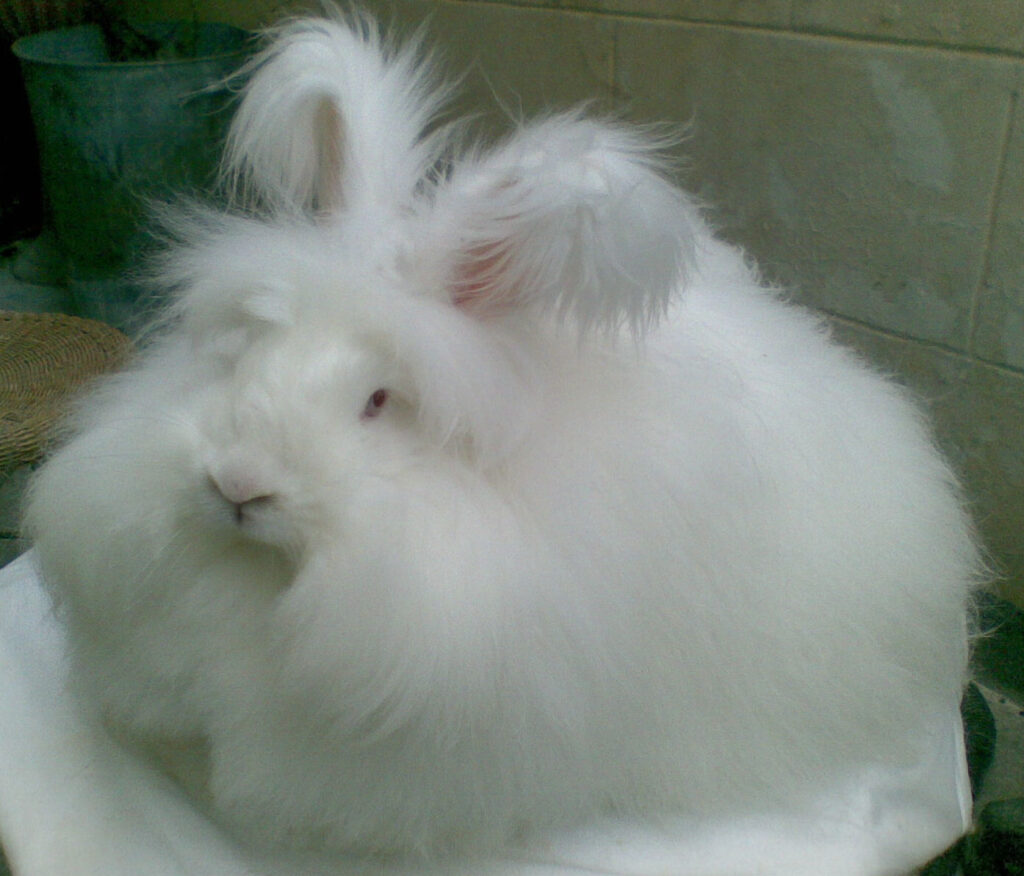The Classic English Angora
The classic English Angora comes in one of the standard colours, and has well woolled and tufted ears (tassel tips). The rabbit has a fringe, with wool long and thick between and behind the ears. Wool on the cheeks is long, but wool around the eyes and the rest of the head is short (the clear face).

“Full faced” Angoras
A certain amount of crossing with imported Angoras has gone on for at least 100 years. In the 1990s, the gene pool of the exhibition Angora had become restricted, and fertility had declined. Importation of rabbits from the US and Europe helped, and the exhibition standard was maintained. In recent times imports have accelerated, and now pictures of “English” Angoras with different appearances appear on social media, causing some confusion. Some English Angoras now have long hair all over their face, and are known as “full faced Angoras.”

Variations in Ears
Tufted Ears (Tassel Tips)
This is the classic English Angora, as shown below.

Frilled Ears
The type of wool seen on the English Angora ears is now much more variable. Some of the imported Angoras have frilled ears, rather than the classic tassel tips.

Waterfall Ears
Some rabbits have very heavily furnished ears, known as waterfall ears.

When people are looking for their first Angora, they often don’t realise that there is a wide variation in facial hair and types of ear now present in the English Angora. Some are disappointed that their rabbit doesn’t look like the famous American Instagram Angora, Wally. Most English Angoras do not. That rabbit has been very carefully shaved!

Broken colours and the Vienna gene
Only certain colours of English Angora are recognised for exhibition. Angora colours are divided into Agouti colours and Self colours. Agouti colours are Brown Grey, Blue Grey, Cinnamon, Chinchilla, Golden and Cream. The Self colours are Smoke, Blue, Chocolate, Lilac, Sooty Fawn, Blue Cream, Sable, Marten Sable and White.
The introduction of the Vienna gene by some pet breeders has resulted in Angoras with broken patterns or white spots on noses, foreheads or feet. These rabbits may be very attractive pet or spinning rabbits, but they cannot be shown. More importantly, if these rabbits are cross bred with exhibition rabbits, the Vienna gene may surface for many generations to come, resulting in white marks in the coats of their descendants. Even if their offspring appear to be all one colour, they may carry the Vienna gene, giving surprise markings in their descendants in future generations.




What is the best type of Angora to choose?
For exhibition, spinning and pet, the best type of Angora to choose is one with a silky non matting coat. The most points for an exhibition Angora are given by the judge for coat. Thirty points are available for wool quality, 25 for wool quantity and length, whilst head and ears attract 10 points only. An Angora with heavy ear furnishings and a poor quality coat will not win.
Full face, frilled ears? Clear face, tufted ears? Clear face, waterfall ears? This is down to the preference of the individual judge. Many feel that the clear face is better for welfare reasons, and that too much wool around the eyes can lead to eye irritation. Most owners of full faced Angoras clip around the eyes to allow the rabbit to see clearly and to prevent eye problems.
Spinners and pet owners require an easy to maintain coat. A silky non matting coat is much easier to maintain and produces more wool than a soft cottony coat, which will tend to mat. When choosing your Angora, think carefully and think beyond ear furnishings. You will be looking after that coat for 8-10 years!
A Show Winning Classic English Angora
